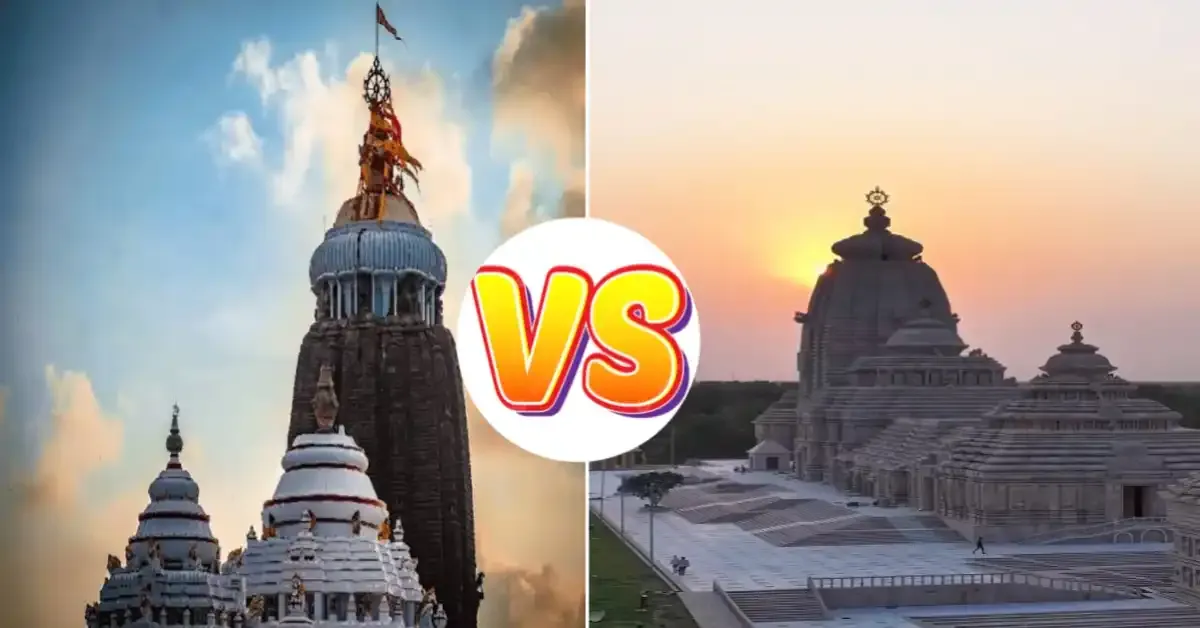The Jagannath Temples in Puri and Digha are both dedicated to Lord Jagannath, an incarnation of Lord Vishnu, and his siblings Balabhadra and Subhadra. While they share religious significance and architectural inspiration, they differ in history, cultural importance, and purpose.
Historical Background
Puri Jagannath Temple: Located in Puri, Odisha, this temple is one of the most revered Hindu pilgrimage sites, known as one of the Char Dham. It was constructed in the 12th century by King Anantavarman Chodaganga of the Eastern Ganga dynasty. The temple has been a significant religious center for centuries, attracting devotees from across India.
Wikipedia Wikipedia +1
Digha Jagannath Temple: Situated in Digha, West Beng modern construc is temple is a tiated by the West Bengal government. Announced in 2018,construction began in 2022, with completion expected in April 2025. It aims to replicate the grandeur of the Puri temple and boost religious tourism in the region.
Architectural Features
Puri Temple: Exemplifies classic Kalinga architecture with a towering structure over 65 meters high. The temple complex includes multiple shrines and is renowned for its intricate carvings and historical significance.
Wikipedia
Digha Temple: Designed as a near-replica of the Puri temple, it adopts the Kalinga architectural style. Standing at 65 meters, it incorporates modern materials like Rajasthan's Banshi Hills sandstone and Vietnamese marble flooring, blending traditional design with contemporary
| Aspect | Puri Jagannath Temple | Digha Jagannath Temple |
|---|---|---|
| Location | Puri, Odisha | Digha, West Bengal |
| Construction Period | 12th Century | 2022 – 2025 (Modern Project) |
| Architecture Style | Kalinga Architecture | Kalinga-Inspired, with Modern Materials |
| Height | Approx. 65 meters | Approx. 65 meters |
| Deities | Lord Jagannath, Balabhadra, Subhadra | Same as Puri |
| Cultural Significance | Part of Char Dham, Historic Pilgrimage | Regional Pilgrimage & Tourism Promotion |
| Festivals | Rath Yatra (Major Annual Festival) | Likely to replicate Rath Yatra celebrations |
| Governing Body | Shree Jagannath Temple Managing Committee | Government Trust including ISKCON & Sanatan Dharma reps |
| Accessibility | Well-connected by road, rail, and air | Near Digha railway station; easily accessible |
Religious and Cultural Significance
Puri Temple: Holds immense religious
importance, being the focal point of the annual Rath Yatra festival, where deities are paraded in grand chariots. The temple's rituals and traditions have been preserved for centuries, making it a cornerstone of Vaishnavism.
Digha Temple: While it mirrors the
religious practices of the Puri temple, its primary purpose is to serve as a cultural and tourist attraction. It aims to provide devotees in West Bengal with a local pilgrimage site, enhancing regional religious engagement.
Location and Accessibility
Puri Temple: Situated in the coastal city of Puri, Odisha, it is accessible via road, rail, and air, making it a prominent destination for pilgrims nationwide.
Digha Temple: Located near the Digha
railway station in West Bengal, it is strategically positioned to attract tourists visiting the popular seaside resort town.
Wikipedia
Puri Temple: Managed by the Shree Jagannath Temple Managing Committee, which oversees the temple's operations and rituals, ensuring adherence to
traditional practices. Wikipedia
Digha Temple: Governed by a trust
established by the West Bengal government, including representatives from ISKCON and the Sanatan Dharma community, reflecting a collaborative approach to temple management.
Conclusion
While both temples are dedicated to the same deities and share architectural similarities, the Puri Jagannath Temple is a historic and deeply spiritual site with centuries-old traditions. In contrast, the Digha Jagannath Temple is a modern initiative aimed at cultural promotion and regional tourism. Together, they represent the enduring devotion to Lord Jagannath and the evolving ways in which this devotion is expressed and celebrated.
Frequently Asked Questions (FAQ)
Q1: What is the main difference between the Puri and Digha Jagannath Temples?
A: The Puri Jagannath Temple is an ancient structure built in the 12th century with deep mythological and cultural significance, whereas the Digha Jagannath Temple is a newly constructed temple (inaugurated in April 30 2025 ) modeled after the Puri temple but designed to promote tourism in West Bengal.
Q2: Are the deities in both temples the same?
A: Yes, both temples worship the same deities-Lord Jagannath, Lord Balabhadra, and Goddess Subhadra. However, the original sacred idols reside in the Puri temple, which is considered the spiritual epicenter for Jagannath worship.
Q3: Is the Digha Jagannath Temple a replica of the one in Puri?
A: The Digha temple is heavily inspired by the Puri temple's Kalinga architecture and design but is not an exact replica. It incorporates modern engineering while reflecting traditional aesthetics.
Q4: Can non-Hindus enter both temples?
A: Non-Hindus are not allowed entry into the Puri Jagannath Temple due to religious restrictions. However, the Digha temple is open to all visitors, regardless of religion, making it more inclusive.
Q5: Which temple hosts the Rath Yatra?
A: Both temples host Rath Yatra celebrations. However, the Rath Yatra at Puri is world-famous and one of the largest religious festivals in India, drawing millions of devotees every year.
Q6: Which one should I visit-Puri or Digha?
A: Visit Puri for a deeply spiritual and historical experience. Choose Digha for a more tourist-friendly, seaside pilgrimage with modern amenities and scenic beauty.

